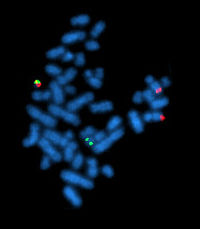
Photo from wikipedia
Reversible protein‐tyrosine phosphorylation is catalyzed by the antagonistic actions of protein‐tyrosine kinases (PTKs) and phosphatases (PTPs), and represents a major form of cell regulation. Acute myeloid leukemia (AML) is an… Click to show full abstract
Reversible protein‐tyrosine phosphorylation is catalyzed by the antagonistic actions of protein‐tyrosine kinases (PTKs) and phosphatases (PTPs), and represents a major form of cell regulation. Acute myeloid leukemia (AML) is an aggressive hematological malignancy that results from the acquisition of multiple genetic alterations, which in some instances are associated with deregulated protein‐phosphotyrosine (pY) mediated signaling networks. However, although individual PTKs and PTPs have been linked to AML and other malignancies, analysis of protein‐pY networks as a function of activated PTKs and PTPs has not been done. In this study, MS was used to characterize AML proteomes, and phospho‐proteome‐subsets including pY proteins, PTKs, and PTPs. AML proteomes resolved into two groups related to high or low degrees of maturation according to French–American–British classification, and reflecting differential expression of cell surface antigens. AML pY proteomes reflect canonical, spatially organized signaling networks, unrelated to maturation, with heterogeneous expression of activated receptor and nonreceptor PTKs. We present the first integrated analysis of the pY‐proteome, activated PTKs, and PTPs. Every PTP and most PTKs have both positive and negative associations with the pY‐proteome. pY proteins resolve into groups with shared PTK and PTP correlations. These findings highlight the importance of pY turnover and the PTP phosphatome in shaping the pY‐proteome in AML.
Journal Title: PROTEOMICS
Year Published: 2017
Link to full text (if available)
Share on Social Media: Sign Up to like & get
recommendations!